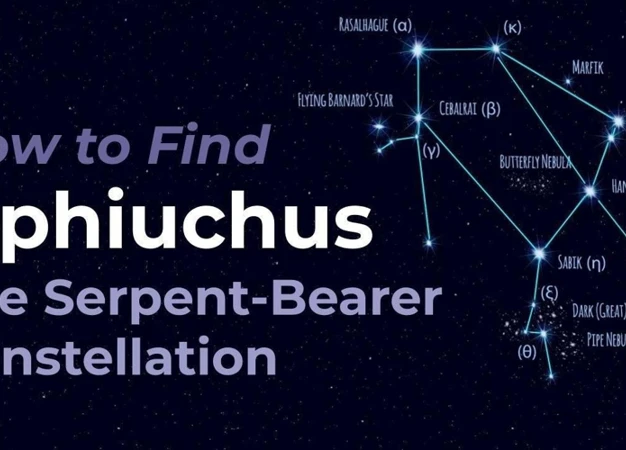The origins of Ophiuchus, the enigmatic constellation that lies between Scorpius and Sagittarius, have long fascinated astronomers and mythologists alike. This celestial wonder has roots in various cultures and mythologies across the world, from ancient Greece to Egypt, China, and India. Exploring the mythological tales surrounding Ophiuchus unveils a rich tapestry of stories, filled with gods, heroes, and astrological significance. Join us on a journey through time and space as we unravel the fascinating myths and legends that have shaped the perception of Ophiuchus, the serpent bearer, and its place in the cosmic panorama.
Contents
- The Ancient Greek Connection
- Other Cultural Interpretations
- The Rediscovery of Ophiuchus
- Conclusion
-
Frequently Asked Questions
- 1. What is Ophiuchus?
- 2. Is Ophiuchus part of the zodiac?
- 3. Who was Asclepius?
- 4. What is the significance of the serpent in Ophiuchus?
- 5. How do other cultures interpret the Ophiuchus constellation?
- 6. Why is Ophiuchus controversial?
- 7. Can I be born under the sign of Ophiuchus?
- 8. What are some personality traits associated with Ophiuchus?
- 9. Can Ophiuchus be seen in the night sky?
- 10. How can I learn more about Ophiuchus and its mythology?
- References
-
Frequently Asked Questions
- 1. What is the significance of Ophiuchus in astrology?
- 2. Is Ophiuchus mentioned in ancient texts or mythologies?
- 3. How did Ophiuchus anger Zeus?
- 4. What is the connection between Ophiuchus and Egyptian mythology?
- 5. Are there any references to Ophiuchus in Chinese astrology?
- 6. How does Ophiuchus fit into Indian astrology?
- 7. What is the controversy surrounding the 13th zodiac sign?
- 8. Why was Ophiuchus left out of the traditional zodiac system?
- 9. How can individuals embrace the energy of Ophiuchus?
- 10. What does the rediscovery of Ophiuchus mean for astrology enthusiasts?
- References
- Read More
The Ancient Greek Connection
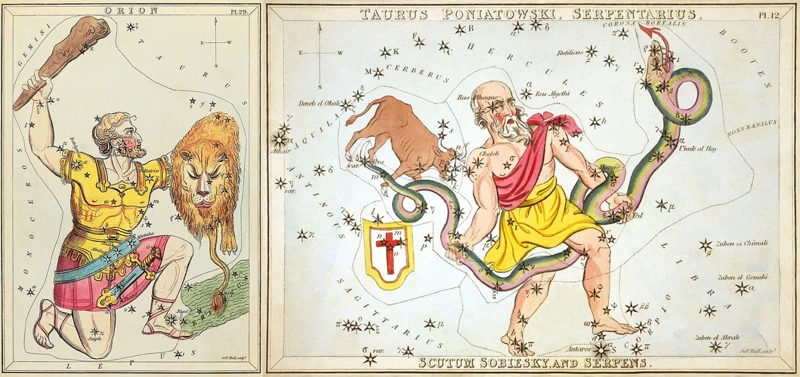
The ancient Greeks held a deep fascination with the stars and the stories they could tell. In their mythology, Ophiuchus was believed to represent the figure of Asclepius, the god of healing and medicine. According to legend, Asclepius possessed incredible healing abilities and was able to resurrect the dead, challenging the natural order of life and death. This astonishing power caught the attention of Zeus, the king of the gods, who feared that such abilities would upset the balance between mortals and the divine. In a fit of anger, Zeus struck down Asclepius with a thunderbolt, forever immortalizing him in the heavens as Ophiuchus, the serpent bearer. This compelling tale of divine intervention and the clash between mortal ambition and the will of the gods has captured the imaginations of generations, showcasing the intricate relationship between Greek mythology and the constellations above.
1.1 The Healing Art of Asclepius
The Healing Art of Asclepius was a central aspect of ancient Greek mythology and medicine. Asclepius, often depicted with a staff entwined by a serpent, was revered as the god of healing and medicine. He possessed great knowledge and skill, and his temples were known as places of miraculous healing. The Greeks believed that Asclepius had the ability to cure ailments and even bring the dead back to life. Patients would seek his divine intervention in the hopes of finding relief from their illnesses and injuries. The temples of Asclepius served as sanctuaries for those in need, where they would undergo rituals, offer sacrifices, and sleep in the hopes of receiving healing dreams or visions from the god himself. The healing methods employed in these temples included a combination of physical treatments, herbal remedies, and spiritual practices. Asclepius’ healing abilities were attributed to his close connection with snakes, which were symbols of rebirth and regeneration in ancient Greek culture. This association between Asclepius and serpents laid the foundation for the constellation of Ophiuchus, where the serpent bearer is forever immortalized in the night sky. To this day, the legacy of Asclepius lives on in the medical field, with his staff and serpent forming the iconic symbol of medicine known as the Caduceus. Exploring the healing art of Asclepius brings us face to face with an ancient understanding of medicine and the enduring power of the serpent bearer’s influence. (Source: /unraveling-secrets-ancient-egyptian-pyramids/)
1.2 The Wrath of Zeus
In the mythological tale of Ophiuchus, the constellation’s connection to Asclepius and his extraordinary healing abilities drew the attention of the mighty Zeus. Zeus, the king of the gods, became concerned that Asclepius’ powers would disrupt the natural order of life and death, unsettling the delicate balance between mortals and immortals. Fearing the potential consequences, Zeus decided to intervene with a powerful display of his wrath. With a thunderbolt in hand, Zeus struck down Asclepius, putting an end to his awe-inspiring healing abilities. The celestial punishment ultimately elevated Asclepius to the status of a constellation, immortalizing his exceptional skills and serving as a reminder of Zeus’ formidable power. This myth exemplifies the Greek belief in the hubris of mortals who dare to challenge the authority of the gods, as well as the punishment that awaits those who overstep their boundaries. The tale of the wrath of Zeus underscores the intricate relationship between mythology and the celestial bodies that grace our skies.
Other Cultural Interpretations
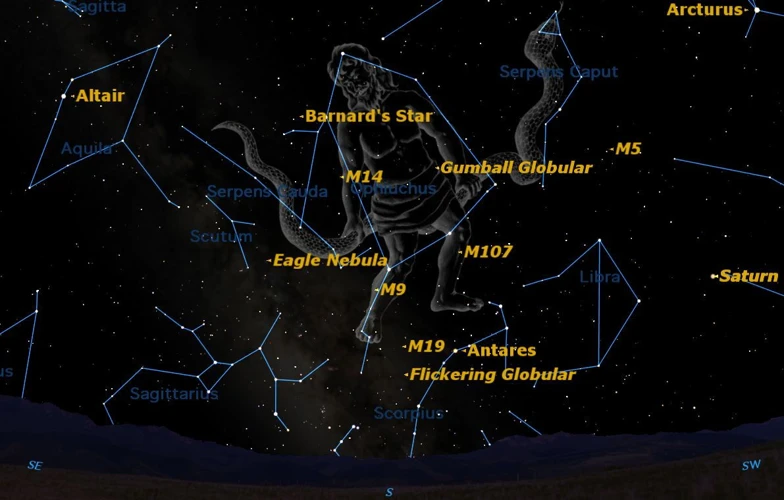
Ophiuchus has left its celestial mark not only in ancient Greek mythology but also in the mythological beliefs of other cultures. In Egyptian mythology, the constellation was associated with the Egyptian god Imhotep, known as the god of healing and medicine. Imhotep, who was also revered as a great architect and scholar, embodied the wisdom and knowledge required to heal the sick. In Chinese astrology, Ophiuchus is believed to be linked to the snake, which represents intelligence, wisdom, and transformation. Similarly, in Indian astrology, Ophiuchus is associated with the nakshatra, or lunar mansion, known as Jyeshtha, symbolizing leadership, power, and prosperity. These diverse cultural interpretations highlight the universal human fascination with the stars and their ability to connect us to the ancient myths and beliefs that have shaped civilizations throughout history. So, delve deeper into the mythological tapestry and explore the captivating stories that surround Ophiuchus, the constellation of wonder.
2.1 The Serpent Bearer in Egyptian Mythology
In Egyptian mythology, the concept of the serpent bearer found its place in the story of the goddess Wadjet. Wadjet, often depicted as a cobra or a woman with a cobra’s head, was one of the oldest Egyptian goddesses associated with protection, healing, and royalty. She was considered the protector of the pharaohs and was believed to ward off evil spirits and illness. The image of Wadjet holding the Uraeus, the sacred serpent symbol, on her crown represented her role as the guardian of kingship. This serpent, known for its venomous and regenerative qualities, symbolized both danger and rejuvenation. It was believed that Wadjet’s mere presence could ward off chaos and bring balance and order to the world. The association of the serpent with healing and protection in Egyptian mythology adds another layer of complexity to the multifaceted character of Ophiuchus, the serpent bearer, as it transcends cultural boundaries and connects different mythological belief systems. To learn more about the enigmatic qualities of Ophiuchus and its representation of resilience and strength, check out our article on ‘Ophiuchus: Resilience and Strength‘.
2.2 Chinese and Indian Astrological Beliefs
Chinese and Indian astrological beliefs also incorporate Ophiuchus into their celestial systems, although their interpretations differ from the Western understanding. In Chinese astrology, Ophiuchus is associated with the snake, which holds significant symbolism in Chinese culture. The snake is seen as a wise and powerful creature, capable of transformation and renewal. In Indian astrology, Ophiuchus is often identified as the sign of Vishakha, one of the nakshatras (lunar mansions) in the Hindu zodiac. Vishakha is associated with power, authority, and determination, reflecting the qualities attributed to Ophiuchus in Western astrology as well. Both Chinese and Indian astrological beliefs recognize the influence and significance of Ophiuchus in their respective systems, adding another layer of depth to the constellation’s mythological origins. Exploring the connections between Ophiuchus and these rich astrological traditions opens up a world of cosmic wisdom and cultural diversity.
The Rediscovery of Ophiuchus
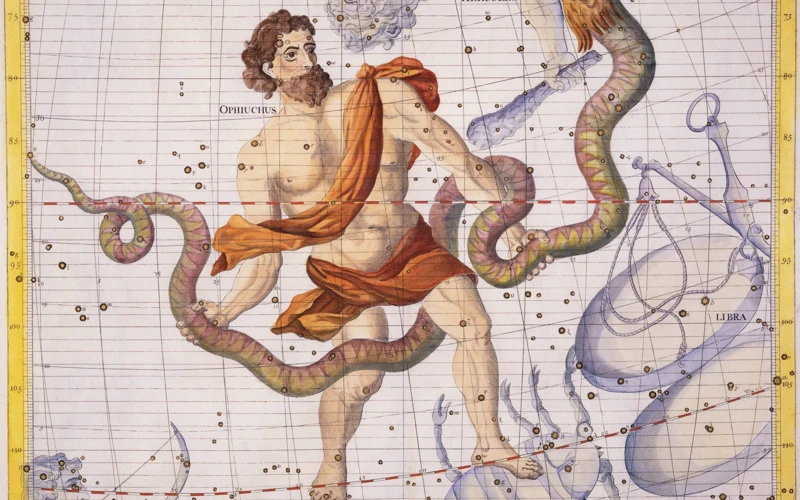
The rediscovery of Ophiuchus in more recent times has sparked controversy and intrigue in the realm of astrology. In 1970, a Swiss astronomer named Parke Kunkle proposed the concept of a 13th zodiac sign, Ophiuchus, based on the alignment of the Earth and the constellations. This revelation caused a wave of speculation and discussion among astrologers and enthusiasts around the world. While astrology traditionally recognizes twelve zodiac signs, the inclusion of Ophiuchus shook the foundations of this ancient system. Some embraced this new addition, seeing it as an opportunity to delve deeper into personality traits and cosmic influences, while others vehemently rejected the notion, arguing that the original twelve zodiac signs held enough significance and meaning. Whether you believe in the power of Ophiuchus or not, its rediscovery undoubtedly sparked a new wave of curiosity and exploration in the world of astrology and the constellation’s alleged impact on our lives and relationships. Dynamic duo of Ophiuchus and Leo love compatibility further adds to the intrigue, as it explores the potential harmonious connection between these two signs and the unique dynamics that can arise from their union.
3.1 The 13th Zodiac Sign Controversy
The controversy surrounding the 13th zodiac sign has been a hot topic of debate in recent years. While the traditional zodiac consists of 12 signs, each representing a specific period of the year, the introduction of Ophiuchus as the 13th sign has created a divide among astrologers and enthusiasts. The inclusion of Ophiuchus is based on the alignment of the constellations with the Earth’s axis, which has shifted over time. Proponents argue that this shift means that individuals born between November 29th and December 17th fall under the influence of Ophiuchus, and their personality traits differ significantly from those attributed to their previous zodiac sign. However, critics argue that this interpretation disrupts the traditional system and undermines the accuracy and reliability of astrology. They claim that the traditional zodiac signs have been established over centuries and should not be altered based on astronomical calculations alone. As the debate rages on, some individuals find themselves identifying more with the traits and characteristics associated with Ophiuchus, sparking interest in a potential shift in astrological practices. Whether Ophiuchus will eventually be accepted as the 13th zodiac sign or remain a point of contention is yet to be seen, but its introduction has certainly ignited a passionate discussion within the astrological community.
3.2 Embracing the Ophiuchus Constellation
Embracing the Ophiuchus constellation has become a source of fascination and controversy in recent years. With the discovery of Ophiuchus as the thirteenth zodiac sign, individuals identifying with this celestial symbol have begun to explore its unique qualities and meanings. Ophiuchus is often associated with attributes such as resilience, strength, and wisdom. Those who align with this constellation embrace their ability to overcome challenges and adapt to difficult situations. Many astrologers have studied the characteristics of Ophiuchus and its influence on personality traits, relationships, and life paths. Additionally, Ophiuchus has sparked interest in the realm of astrology, leading to discussions about compatibility with other signs and the significance of the Ophiuchus-Leo dynamic duo. The inclusion of Ophiuchus as a recognized zodiac sign has opened up new avenues for self-discovery and exploration for those who resonate with its energy. Whether one finds solace in the serpent bearer’s mythological origins or feels a deep connection with its astrological implications, embracing the Ophiuchus constellation can be a profound and enlightening journey of self-discovery.
Conclusion
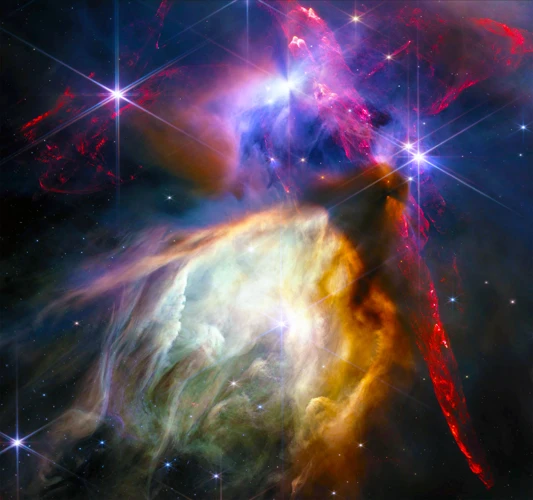
In conclusion, the mythological origins of Ophiuchus have woven a captivating narrative across various cultures and time periods. From the ancient Greeks’ connection to the healing art of Asclepius to the serpent bearer’s significance in Egyptian, Chinese, and Indian mythology, Ophiuchus has left an indelible mark on our collective imagination. Despite controversy surrounding its status as the 13th zodiac sign, many have embraced Ophiuchus and celebrate its unique qualities and astrological symbolism. The rediscovery of this constellation reminds us of the vastness of the universe and the enduring allure of myth and legend. Ophiuchus invites us to gaze at the stars with wonder and contemplate the mystical stories that have shaped our understanding of the cosmos. Whether you view Ophiuchus as a constellation of healing, resilience, or love, its mythological origins continue to fascinate and inspire us to explore the celestial wonders above.
Frequently Asked Questions
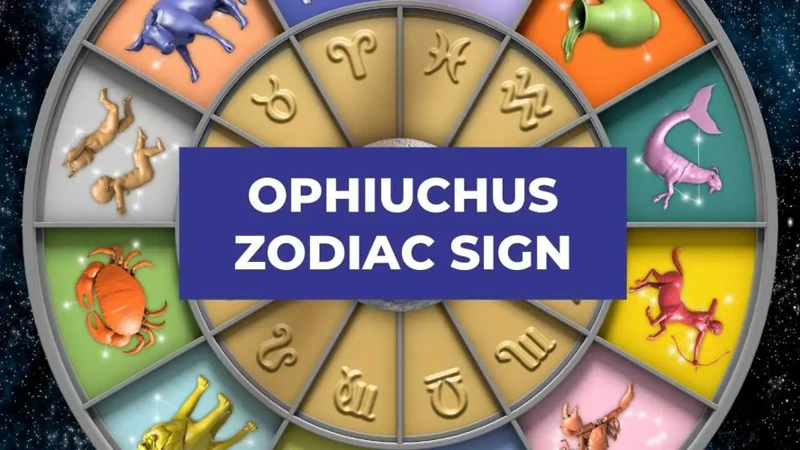
1. What is Ophiuchus?
Ophiuchus is a constellation located in the celestial sphere, known as the serpent bearer or the serpent holder. It lies between the constellations of Scorpius and Sagittarius.
2. Is Ophiuchus part of the zodiac?
While Ophiuchus is not officially recognized as one of the twelve zodiac signs in Western astrology, it holds its own significance in various astrological traditions around the world.
3. Who was Asclepius?
Asclepius was a prominent figure in Greek mythology and was associated with healing and medicine. He was often depicted as a healer with incredible abilities and was later immortalized as the constellation Ophiuchus.
4. What is the significance of the serpent in Ophiuchus?
The serpent in Ophiuchus represents the healing serpent that was intertwined around the staff of Asclepius, symbolizing the medical profession and the concept of healing.
5. How do other cultures interpret the Ophiuchus constellation?
In Egyptian mythology, Ophiuchus is associated with the god Imhotep, who was also revered for his healing abilities. In Chinese and Indian astrology, Ophiuchus is recognized as an important constellation with its own astrological interpretations.
6. Why is Ophiuchus controversial?
Ophiuchus became a subject of controversy when some astrologers proposed it as the thirteenth zodiac sign, disrupting the traditional twelve-sign system. However, this proposal is not widely accepted in mainstream astrology.
7. Can I be born under the sign of Ophiuchus?
As per the Western astrological system, which primarily considers the twelve zodiac signs, Ophiuchus is not considered a zodiac sign. However, individuals born between late November and early December may associate themselves with Ophiuchus based on their birthdates.
8. What are some personality traits associated with Ophiuchus?
While there are no widely recognized personality traits specifically associated with Ophiuchus, those who closely identify with this constellation often embrace traits such as resilience, healing, and a deep spiritual connection.
9. Can Ophiuchus be seen in the night sky?
Yes, Ophiuchus can be observed in the night sky, particularly during the summer months in the northern hemisphere. It can be located between the constellations of Sagittarius and Scorpius.
10. How can I learn more about Ophiuchus and its mythology?
Exploring ancient mythological texts, astrology books, and websites dedicated to astronomy and astrology can provide valuable insights into the fascinating history and mythology surrounding Ophiuchus.
References
Frequently Asked Questions

1. What is the significance of Ophiuchus in astrology?
Ophiuchus holds significance in astrology as it is believed to be the 13th zodiac sign, representing healing, transformation, and wisdom.
2. Is Ophiuchus mentioned in ancient texts or mythologies?
Yes, Ophiuchus is mentioned in ancient Greek mythology as the constellation associated with Asclepius, the Greek god of healing.
3. How did Ophiuchus anger Zeus?
Ophiuchus angered Zeus by using his healing abilities to revive the dead. This threatened the balance of life and death and angered the ruler of the gods.
4. What is the connection between Ophiuchus and Egyptian mythology?
In Egyptian mythology, Ophiuchus is associated with the god Imhotep, who was known for his healing powers and wisdom.
5. Are there any references to Ophiuchus in Chinese astrology?
Yes, in Chinese astrology, Ophiuchus is associated with the snake spirit, symbolizing wisdom, intuition, and transformation.
6. How does Ophiuchus fit into Indian astrology?
In Indian astrology, Ophiuchus is linked to the nakshatra (lunar mansion) called Serpentarius, representing healing and spiritual transformation.
7. What is the controversy surrounding the 13th zodiac sign?
The controversy revolves around whether or not Ophiuchus should be recognized as an official zodiac sign, alongside the traditional 12 signs.
8. Why was Ophiuchus left out of the traditional zodiac system?
Ophiuchus was left out of the traditional zodiac system because it did not align with the 12-month calendar used by ancient astrologers.
9. How can individuals embrace the energy of Ophiuchus?
Individuals can embrace the energy of Ophiuchus by exploring healing practices, seeking wisdom, and embracing personal transformation.
10. What does the rediscovery of Ophiuchus mean for astrology enthusiasts?
The rediscovery of Ophiuchus adds a new layer of complexity and depth to astrology, offering enthusiasts an opportunity to explore additional aspects of their personality and life journey.
